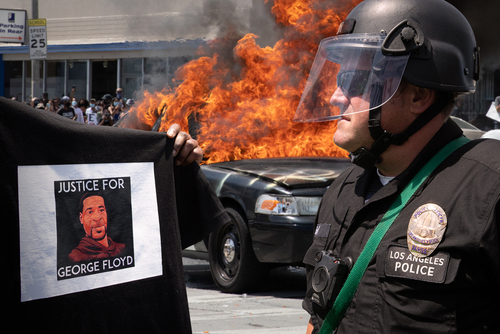
The circumstances surrounding the death of George Floyd, a topic under intense scrutiny and debate for over three years, have been revisited. The prevailing narrative that George Floyd was murdered by Derek Chauvin, a white police officer, has been challenged based on new court documents.
On May 25, 2020, George Floyd, a Black man, died while in police custody. The incident, captured on video, showed Officer Derek Chauvin kneeling on Floyd’s neck for over nine minutes.
This sparked widespread protests across the United States under the “Black Lives Matter” banner, advocating against police brutality.
Ep. 32 You’ll be shocked to learn this, but it turns out the whole George Floyd story was a lie. pic.twitter.com/4vDXBStHf5
— Tucker Carlson (@TuckerCarlson) October 20, 2023
Consequently, Chauvin was convicted of second-degree unintentional murder, third-degree murder, second-degree manslaughter, and sentenced to 21 years in prison.
However, new information from a court case in Hennepin County, Minnesota brought a fresh perspective to the case. The case involves a deposition from Amy Sweasy, a prosecutor in the area. She filed a lawsuit against her former boss, Mike Freeman, alleging sex discrimination and retaliation.
As part of this legal endeavor, a wealth of documents and testimonies surfaced, providing an unfiltered view into the internal workings and pressures that shaped the high-profile case against Chauvin and his fellow officers.
Patrick Lofton, Senior Assistant County Attorney who worked on police use-of-force cases with Sweasy, detailed the pressure prosecutors were under to file charges. He stated the city was “burning down,” highlighting the urgency of the moment.
Although Lofton believed there was “probable cause to charge Chauvin with third-degree murder,” he felt the external pressure was “insane.”
Taxpayers were forced to pay George Floyd’s family $27,000,000 after he died from an overdose in police custody in 2020.
Now that medical documents have proven Derek Chauvin did not kill him, should his family be ordered to give taxpayers their money back? pic.twitter.com/RNnKF4w4Xv
— Matt Wallace (@MattWallace888) October 21, 2023
Among the documents and testimonies, Sweasy discussed a crucial conversation she had with Hennepin County Medical Examiner Dr. Andrew Baker the day after Floyd’s death.
Dr. Baker reportedly said there were “no medical findings that showed any injury to the vital structures of Mr. Floyd’s neck. There were no medical indications of asphyxia or strangulation.”
This revelation is critical because it directly challenges the mainstream narrative that George Floyd was “murdered” due to asphyxiation from the knee-to-neck restraint.
Instead, the evidence suggests George Floyd died of what could be classified as “natural causes,” exacerbated by his drug use and a fatal concentration of fentanyl in his system.
This new perspective on the George Floyd case, based on fresh court documents, challenges the prevailing narrative and calls for a more nuanced understanding of the circumstances surrounding his death.













